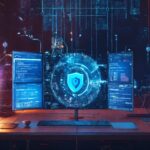Introduction
As we dive deeper into the twenty-first century, the tempo of technological innovation is accelerating exponentially. With each passing year, new technologies are emerging and evolving, reshaping the way we live and work. In this blog post, we will explore some of the most promising technologies that are expected to dominate the scene in 2024.
The Growing Impact of Artificial Intelligence
As we barrel headlong into the future, Artificial Intelligence (AI) remains at the forefront of technology, becoming increasingly complex and omnipresent. Anticipate AI’s prowess in 2024 as it stretches its tendrils further, revolutionizing diverse sectors from healthcare to transportation.
Imagine AI serving up highly customized experiences, delivering predictive analytics with uncanny accuracy, and running autonomous operations that redefine productivity. From startup ventures to Fortune 500 companies, there’s an increasing adoption of AI-powered solutions to streamline processes, enhance efficiency, and ignite productivity.
Another fascinating development to watch for is in the realm of natural language processing. As this field of AI advances, our virtual assistants will undergo significant evolution. Picture your AI assistant, maybe Alexa or Siri, becoming more conversational, comprehending the subtleties of human language, and becoming sharply context-aware.
In essence, the influence of AI will surge like never before in 2024, altering the way we perceive technology, its capabilities, and its potential role in shaping our world.
Virtual Reality’s Leap from Gaming to Practical Applications
Virtual Reality (VR), long associated with video games and entertainment, is preparing to take center stage in a myriad of practical applications by 2024. The potential for VR to transcend the boundaries of reality is immense, and its adoption across various sectors is set to redefine traditional practices.
Imagine walking through the hallways of an internationally renowned university, attending a lecture in real-time, and interacting with classmates—all from the comfort of your living room. This immersive learning experience will become a reality with VR, creating unprecedented opportunities in education and democratizing access to high-quality learning worldwide.
Meanwhile, in the healthcare sector, VR could be the next big thing. Surgeons could harness VR for intricate operations, using it as a guiding tool for precise surgical procedures. This could translate to fewer medical errors, safer operations, and improved patient outcomes.
The world of real estate is another domain where VR is set to make its mark. Prospective homeowners could virtually traverse through properties, inspecting every nook and cranny without having to step foot outside their current homes. This not only saves time and resources but also offers a comprehensive view of the property, helping buyers make informed decisions.
In 2024, VR’s journey from the gaming console to the real world is expected to be one of the biggest tech transitions, transforming the way we learn, heal, and even buy homes. Its impact will be far-reaching and its applications, truly revolutionary. This leap will open up new avenues, heralding a new era in digital innovation.
The Wonders of Quantum Computing
Quantum Computing is a fledgling technological marvel that’s all set to create ripples in the tech world. Its promise of harnessing the principles of quantum physics to deliver computing prowess beyond anything we’ve experienced is nothing short of revolutionary. By 2024, the world could witness this remarkable technology start to blossom and come into its own.
Picture solving computational conundrums that are currently beyond the realm of possibility. Imagine a new breed of computing power that can simulate the very molecules of a new, life-saving drug or accurately predict intricate weather patterns to safeguard communities. Quantum Computing carries the potential to bring these scenarios to life.
We’re still navigating the early stages of this field, and we’ve only scratched the surface of what Quantum Computing can offer. As the technology evolves, we can expect remarkable strides in areas that demand extensive computational muscle. By 2024, we’re likely to see the influence of Quantum Computing stretch into cryptography, enabling the creation of virtually uncrackable codes, thereby bolstering our digital defenses. The forecasting of weather patterns with extraordinary precision could become a norm, empowering us to preempt and prepare for climatic anomalies better.
Pharmaceutical research could also get a quantum boost. The ability to simulate molecules with such precision could accelerate the discovery of new drugs, setting the stage for medical breakthroughs.
So, as we inch closer to 2024, keep your eyes on the quantum horizon. The potential of Quantum Computing is immense, and its ripple effects promise to reverberate across industries, altering the technology landscape in profound ways.
Biotechnology and the Power to Change Lives
As we embark on the journey towards 2024, biotechnology is gearing up to redefine the medical landscape and, by extension, the fabric of human lives. The era of ‘one-size-fits-all’ medication is receding, making way for the dawn of personalized medicine. Genomic advances are propelling this transformation, equipping us with the ability to customize treatments based on an individual’s genetic makeup. This revolutionary shift could result in highly effective treatments with reduced side effects, enhancing patient outcomes substantially.
Further on the horizon, we see the shimmering possibilities of synthetic biology. Picture engineering life forms tailored to perform specific tasks. For instance, we could design microorganisms that could play a significant role in environmental conservation by eliminating harmful waste.
The growth of biotechnology in 2024 will also usher in an era of bio-printing, where human organs for transplants could be created in a laboratory, significantly reducing the dependency on organ donations. These lab-grown organs could offer a new lease of life for patients in dire need of organ transplants.
Similarly, advancements in genetic editing tools like CRISPR could transform disease treatment by editing out disease-causing genes. This could potentially lead to a future where debilitating genetic diseases become a thing of the past.
Thus, as 2024 approaches, we can anticipate biotechnology to push boundaries and unlock new possibilities, opening doors to unprecedented medical marvels that hold the promise to drastically improve and prolong human lives. In the broader perspective, these breakthroughs are not just about innovative medical treatments; they represent the power of technology to change lives profoundly.
The Rise of 5G and Its Impact on IoT
Imagine a world where everything around you – from your car to your refrigerator to the city streets – is connected, communicating, and seamlessly integrated. This is the vision of the Internet of Things (IoT), and the emergence of 5G technology is set to turbocharge its realization by 2024.
Picture lightning-fast, ultra-reliable connections that empower the surge of IoT devices, paving the way for real-time, machine-to-machine communication. This will transform a multitude of sectors.
In the manufacturing industry, 5G-enabled IoT devices could monitor machinery in real-time, predict maintenance needs, and prevent costly breakdowns. This will usher in a new era of efficiency and productivity.
In the realm of agriculture, farmers could leverage 5G-connected drones and sensors to monitor crop health, automate irrigation, and maximize yield. This technology infusion will redefine farming practices, bringing precision and sustainability to the forefront.
On a larger scale, the 5G IoT revolution will reshape our urban landscapes into smart cities, where everything from traffic lights to waste management systems can interact and optimize for efficiency. This could lead to smoother traffic, cleaner streets, and overall enhanced quality of urban life.
Within our homes, 5G will take the concept of smart homes to a new level. Picture your fridge ordering groceries when you’re running low, or your heating system adjusting the temperature based on your schedule.
The potential of 5G to amplify the capabilities of IoT is immense, and as we march towards 2024, this technology duo is all set to redefine connectivity, automation, and convenience in ways we’ve yet to imagine.
The Growing Popularity of Blockchain and Cryptocurrency
The ripple effect of blockchain technology and cryptocurrency is expanding across the globe, and their adoption is expected to be more widespread by 2024. The core appeal of blockchain lies in its unparalleled transparency and ironclad security. It’s a system where every transaction leaves a trace, offering a foolproof trail that’s virtually impervious to fraud. This robust integrity is stirring interest across diverse sectors, with the potential to overhaul traditional practices in supply chain management and finance.
Picture a world where blockchain revolutionizes supply chains, bringing an unprecedented level of traceability. You’d be able to know exactly where your coffee beans were grown, or the journey your clothes took from cotton field to retail rack. In finance, blockchain could establish an unhackable, decentralized framework that eliminates intermediaries, reduces costs, and expedites transactions.
Meanwhile, cryptocurrencies, the digital descendants of blockchain, are inching towards becoming recognized forms of currency. This futuristic money is not bound by geographical borders or central banks, offering an alternative, decentralized economic system. Envision a future where you can buy your morning coffee or even a house with Bitcoin, Ethereum, or maybe even a cryptocurrency that’s yet to be conceived.
However, this journey to widespread adoption isn’t without challenges. The volatility of cryptocurrencies and the regulatory complexities they bring along are significant hurdles to be navigated. Nonetheless, as we approach 2024, expect to see blockchain and cryptocurrencies firmly entrenched in our financial landscape, driving digital innovation, and disrupting traditional norms. The fusion of blockchain and cryptocurrencies carries the potential to rewire our economic system, offering a transparent, secure, and decentralized alternative. So, buckle up for an exciting ride as these technologies shape the contours of our digital economy.
Cybersecurity in a Digitally Connected World
In the rapidly digitizing landscape of 2024, the shadow of cyber threats looms large. As we continue to intertwine our lives with technology, safeguarding our digital universe becomes a necessity rather than an option. The key lies in staying one step ahead, anticipating threats before they strike, and that’s precisely where AI-driven threat detection steps in.
Envision a cybersecurity infrastructure powered by the intelligence of AI. Picture a system that continuously learns from patterns, anticipates vulnerabilities, and deploys countermeasures in real-time. This dynamic digital sentinel could be our most potent shield in the relentless battle against cyber threats.
However, as we’ve noted earlier, the advent of Quantum Computing is on the horizon. And with it comes the potential for quantum-level cyber threats. But fear not, for technology has a solution up its sleeve. Quantum cryptography, leveraging the peculiarities of quantum physics, is poised to offer a level of security that is, theoretically, unbreachable.
Imagine a future where your data is encoded using the principles of quantum physics, rendering it immune to any form of eavesdropping or interception. This could revolutionize data security, erecting a virtually impenetrable barrier against cyber threats.
In the grand scheme of things, the cybersecurity landscape of 2024 appears to be a battleground where AI, quantum computing, and cryptography cross swords with an array of cyber threats. In this high-stakes game of digital chess, the key to victory lies in constant innovation and adaptation. So, gear up to witness the exciting evolution of cybersecurity in the digital world of 2024.
The Emergence of Sustainable Tech
As we hurtle towards 2024, one critical aspect of technology that stands poised to take center stage is sustainable technology. As the world finds itself grappling with the sobering consequences of climate change, the focus is shifting towards environmentally-friendly solutions. Innovative technologies that tap into renewable energy resources, zero-emission electric vehicles, and high-tech carbon capture methodologies are all gearing up to lead this green revolution.
Visualize harnessing the unlimited power of the sun, wind, and sea through cutting-edge solar panels, wind turbines, and tidal energy converters. These devices, through advancements in efficiency and affordability, are expected to reshape our energy landscape, paving the way towards a cleaner, more sustainable world.
Electric vehicles, too, are set to shift gears. Anticipate a future where charging stations outnumber gas stations, and the hum of an electric motor replaces the roar of a combustion engine. Not only does this promise cleaner air, but also a significant reduction in carbon emissions contributing to global warming.
Now, let’s envision advanced carbon capture technology that can trap and store CO2 emissions before they escape into the atmosphere. Couple this with AI-driven analytics to track and manage our carbon footprints, and you’ve got a powerful arsenal in the fight against climate change.
As we prepare for the dawn of 2024, sustainable technology is not just an option; it’s an absolute necessity. The combination of these green technologies could very well be our ticket to a more sustainable future, preserving our planet for generations to come. So, hold onto your hats, because the sustainable tech revolution is just around the corner!










